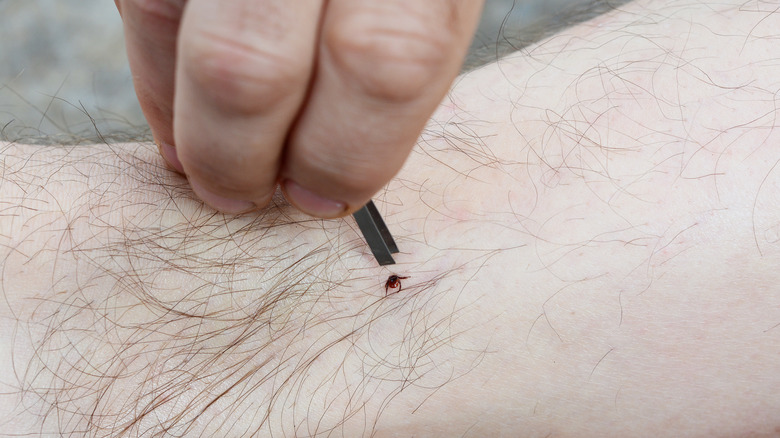What You Should Do If A Tick Head Breaks Off From Its Body
Ticks are eight-legged insects related to spiders (via WebMD). Their primary food source comes from animal and human blood. UpToDate explains ticks range in size from as small as a pencil point to as large as a pencil eraser. Seattle Children's notes ticks may be easier to see if they have been attached for some time, as their small, flat, oval body swells with blood and becomes more prominent as they feed.
Johns Hopkins Medicine explains that many tick bites are harmless. Still, they can carry a variety of serious diseases that can infect humans and animals, including Lyme disease, ehrlichiosis, and babesiosis. According to the American Kennel Club (AKC), pathogen transmission can begin between three to six hours after the initial bite, so removing a tick quickly can help prevent infection. However, ticks secrete saliva containing anesthetic properties before they insert a barbed feeding tube, so a host may not feel the tick bite (per Centers for Disease Control and Prevention). For this reason, a tick can go unnoticed for several days while it feeds on the host.
Ticks can also excrete a cement-like substance that helps them stay attached to a host, and the head may break off and remain beneath the skin after removing the body. Here's what you should do if a tick head breaks off from its body.
How to remove a tick head
If a tick's head breaks off from its body, Lancaster Pediatric assures it will usually come out on its own over time, and there is often no need to remove it manually. However, an embedded tick head can sometimes cause irritation, inflammation, or infection. If the head does not come out on its own, Healthline warns a hard bump may form over it as the skin heals. Improperly removing a tick head from your skin can also inflame the skin or cause an infection.
To safely remove a tick head, Seattle Children's advises first removing any large pieces of the tick's mouthparts (head) visible above the skin. To do this, Healthline recommends using clean, sterilized, fine-tipped tweezers to firmly grasp the head as close to the skin as possible. Pull it out with a firm, steady, straight tug. If you don't have tweezers, you can try using a sterilized needle to remove a tick head. Seattle Children's instructs to clean the skin with rubbing alcohol and try to scrape the parts out with the needle (like you're removing a splinter). If small pieces remain, do not dig into the skin further, as this may cause more irritation or result in a skin infection (via Dartmouth Health). Instead, wait for the pieces to shed from the skin naturally.


